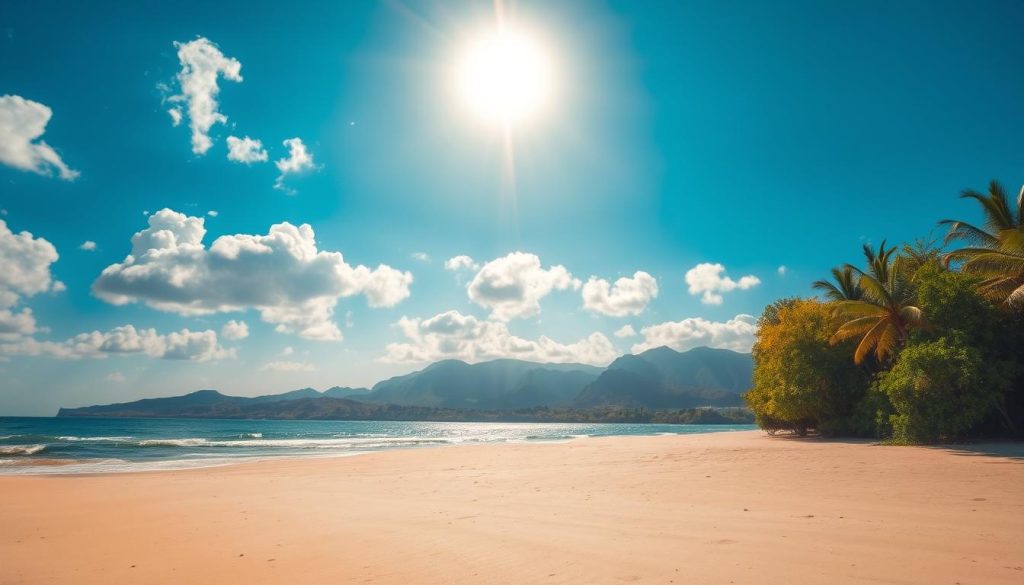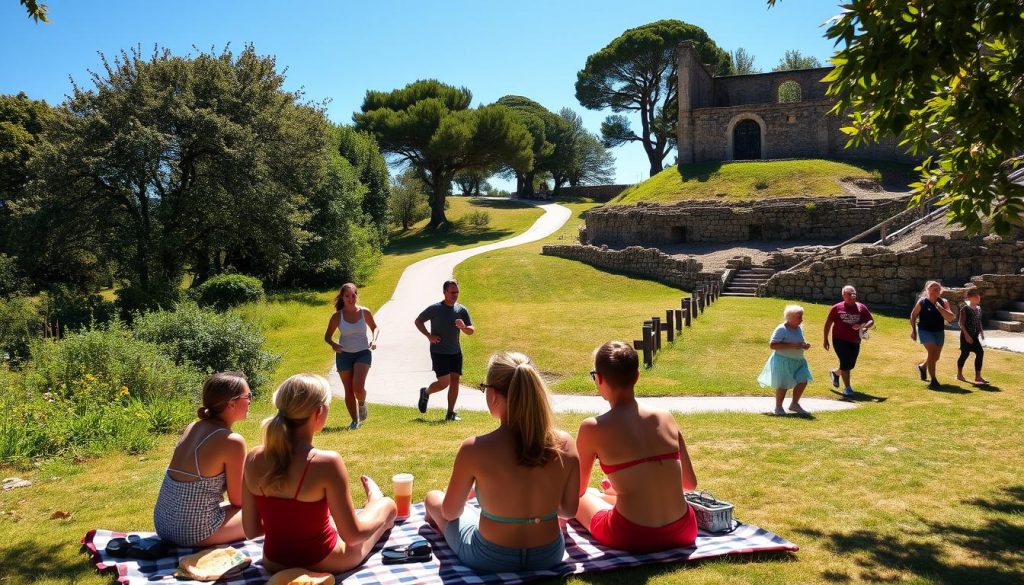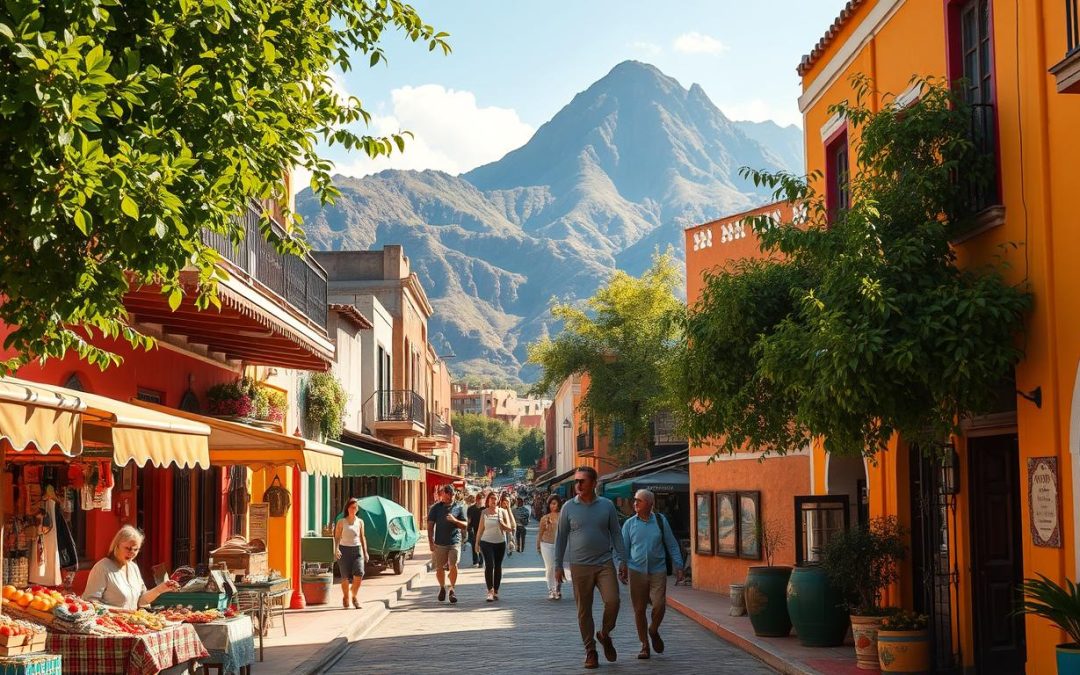Ever wondered if there’s a perfect time to explore a destination that offers both sunny beaches and vibrant cities? Planning a trip that aligns with ideal weather conditions can make all the difference in your experience. From the tropical coasts to the cooler highlands, the climate varies widely across this diverse country.
September, for instance, is a hidden gem. With cooler temperatures, fewer crowds, and lower prices, it’s a great time to visit. Whether you’re drawn to bustling urban centers or serene beach towns, understanding the seasonal patterns can help you make the most of your journey.
This guide dives into the best times to visit, considering factors like climate, festivals, and tourist seasons. Ready to plan your weather-savvy adventure? Let’s get started.
Key Takeaways
- Different regions offer unique climate experiences, from tropical coasts to cooler highlands.
- September is ideal for cooler weather, fewer crowds, and budget-friendly travel.
- The best time to visit depends on your destination and planned activities.
- Rainy seasons vary across the country, impacting travel plans.
- Festivals and tourist seasons can influence the best time to explore.
Understanding Mexico’s Climate and Tourist Seasons
Understanding the climate of a destination ensures a smoother and more enjoyable journey. From tropical coasts to cooler highlands, the weather varies widely across regions. This diversity affects when and where you should plan your trip.
Diverse Weather Zones Explained
The country is divided into several climatic zones. Tropical regions, like coastal areas, experience high humidity and warm temperatures year-round. Arid zones, found in the north, are hot and dry. Temperate regions, such as the highlands, offer cooler weather, especially at night.
At sea level, you’ll find warmer conditions, while mountainous areas are cooler. For example, coastal hotspots like Tulum average less than three rainy days monthly during the dry season. In contrast, Mexico City sees over three-quarters of its annual rainfall between May and October.
High, Shoulder, and Low Tourist Seasons
Tourist seasons are influenced by these weather patterns. The high season, from December to April, is ideal for sunny beach days but comes with higher prices. Shoulder months, like May and November, offer a balance of good weather and fewer crowds. The low season, from June to October, is rainy but budget-friendly.
For instance, resort rates in Cancún drop by up to 60% during the low season. However, this period also coincides with hurricane activity on the Caribbean coast. Understanding these patterns helps you choose the right time for your trip.
| Region | High Season | Shoulder Season | Low Season |
|---|---|---|---|
| Coastal Areas | December-April | May, November | June-October |
| Highlands | November-April | May, October | June-September |
| Arid Zones | October-March | April, September | May-August |
Seasonal weather impacts travel decisions. Coastal humidity peaks in August, while December nights in Guadalajara might require a light sweater. By aligning your plans with the right season, you can enjoy a more comfortable and cost-effective trip.
When to Visit: Mexico: Best Months for a Weather-Savvy Trip
Planning your journey around the right weather conditions can elevate your travel experience. Temperature and humidity play a significant role in determining the best time to explore. Whether you’re seeking sunny beaches or cooler highlands, understanding these factors ensures a more enjoyable trip.

Optimal Timing Based on Temperature and Humidity
April is a standout month for many regions. It marks a transition between dry and rainy seasons, offering mild temperatures and manageable humidity. Coastal areas like Cancún see average highs of 85°F, while inland cities like Oaxaca remain comfortably warm.
Humidity levels vary throughout the year. Coastal destinations experience higher humidity during the summer months, making spring and fall more appealing. In contrast, highland areas like Mexico City maintain cooler, drier conditions year-round.
Here’s how different months shape your travel experience:
- April: Ideal for coastal and inland destinations with pleasant weather and fewer crowds.
- June-October: The rainy season brings lush landscapes but higher humidity and occasional storms.
- November-March: Cooler, drier weather perfect for exploring cities and cultural sites.
The rainy season impacts travel plans differently across regions. Coastal areas like the Yucatán Peninsula see heavy rainfall from June to September, while highlands experience shorter, afternoon showers. Timing your trip outside these months ensures smoother travel.
Practical examples can help you decide. For beach lovers, April offers sunny days without the intense heat of summer. Cultural explorers might prefer November, when cooler temperatures make sightseeing more comfortable. By aligning your plans with these weather patterns, you can enjoy a seamless and satisfying journey.
Planning Your Trip Around Local Festivals and Events
Immersing yourself in local festivals can transform your vacation into a cultural adventure. From vibrant parades to intimate town celebrations, these events offer a unique window into the heart of the area. Timing your visit around these occasions ensures you experience the destination at its most lively and authentic.
Major Celebrations and Cultural Insights
One of the most iconic events is the Day of the Dead, celebrated on November 1st and 2nd. This deeply spiritual festival honors loved ones with altars, marigolds, and candlelit processions. Another highlight is Christmas, which spans from December 16th to 24th with Las Posadas, reenacting Mary and Joseph’s search for shelter.
In Oaxaca, the Radish Festival on December 23rd showcases intricate carvings made from giant radishes. These events are not just spectacles but opportunities to connect with local traditions and stories.
Seasonal Events Not to Miss
If you’re visiting in December, don’t miss Three Kings Day on January 6th, celebrated with parades and gifts. The Guelaguetza Festival in July highlights indigenous culture with music, dance, and traditional attire. Each region adds its own flavor, making every celebration unique.
Here are some key events to plan around:
- Day of the Dead: November 1st – 2nd
- Las Posadas: December 16th – 24th
- Radish Festival: December 23rd
- Three Kings Day: January 6th
These festivals are more than just dates on a calendar—they’re a chance to experience the soul of the area. Whether you’re drawn to the solemn beauty of the Day of the Dead or the joyful chaos of Christmas, these moments will leave a lasting impression on your vacation.
Navigating the High, Shoulder, and Low Seasons
Timing your trip to avoid crowds can make your experience more enjoyable and cost-effective. Understanding the differences between high, shoulder, and low seasons helps you plan smarter. Each season offers unique advantages, from budget-friendly travel to quieter destinations.

Benefits of Traveling During Shoulder Seasons
Shoulder seasons, like November and May, strike the perfect balance. You’ll enjoy pleasant weather, fewer crowds, and lower prices. For example, resort rates in popular coastal areas drop by up to 40% during these months.
November is particularly appealing. The summer rains have passed, leaving lush landscapes and comfortable temperatures. It’s an ideal time for outdoor activities like hiking or exploring cultural sites without the hustle of peak season.
Here’s why shoulder seasons are worth considering:
- Cost Savings: Flights and accommodations are often cheaper.
- Fewer Crowds: Popular attractions are less crowded, making your experience more relaxed.
- Pleasant Weather: Mild temperatures and manageable humidity enhance your trip.
Managing Crowds in Peak Periods
If you must travel during high season, there are ways to manage the crowds. Plan your visits to popular spots early in the morning or late in the evening. These times are typically quieter and offer a more peaceful experience.
Booking ahead is crucial. Reserve tickets for attractions and restaurants to avoid long waits. Consider exploring lesser-known destinations that are equally stunning but less crowded.
Here are some practical tips for peak season travel:
- Early or Late Visits: Explore attractions during off-peak hours.
- Alternative Destinations: Discover hidden gems away from the crowds.
- Plan Ahead: Book accommodations and activities in advance to secure your spot.
By understanding the seasons and planning strategically, you can make the most of your trip. Whether you choose the shoulder season for its balance or navigate the high season with smart tips, your experience will be unforgettable.
Region-Specific Travel Insights
Discover how different regions offer unique travel experiences tailored to your preferences. Whether you’re drawn to bustling cities, serene highlands, or sunny beaches, each area has its own charm and ideal timing. Understanding these differences ensures a trip that aligns with your interests and expectations.
Exploring Urban Centers and High Highlands
Urban centers like Mexico City and Guadalajara are perfect for cultural enthusiasts. These cities offer cooler climates, especially from November to April, making sightseeing comfortable. Explore local markets, museums, and historic sites without the intense heat of summer.
Highland regions, such as Oaxaca, are known for their temperate weather. The dry season, from November to April, is ideal for outdoor activity like hiking and exploring ancient ruins. These months also coincide with vibrant festival celebrations, adding a cultural layer to your trip.
Coastal Areas and Beach Destinations
If you’re dreaming of a beach getaway, coastal areas like Cancún and Puerto Vallarta are best visited from October to May. These months offer sunny skies, warm waters, and minimal rainfall, perfect for snorkeling, swimming, and relaxing on the sand.
During summer, coastal regions experience higher humidity and occasional storms. However, this is also when you’ll find fewer crowds and lower prices. If you’re flexible with your plans, this can be a budget-friendly time to visit mexico’s stunning beaches.
Here’s a quick comparison of regional highlights:
- Urban Centers: Cooler weather, cultural tours, and local markets. Best from November to April.
- Highlands: Temperate climate, outdoor activity, and festival celebrations. Ideal from November to April.
- Coastal Areas: Sunny beaches, water sports, and vibrant nightlife. Perfect from October to May.
Whether you’re planning to visit mexico for its cities, highlands, or beaches, aligning your trip with the right season ensures a memorable experience. Consider your preferred activity and weather conditions to make the most of your journey.
Weather Considerations for Outdoor and Cultural Activities
Choosing the right weather for your activities can make or break your travel experience. Whether you’re planning a beach getaway or an inland adventure, understanding seasonal patterns ensures a smoother trip. From sunny shores to cultural hotspots, weather plays a key role in shaping your journey.

Ideal Conditions for Beach Vacations
Beach vacations thrive in sunny, dry weather. October is a prime month for coastal destinations, offering warm temperatures and minimal rainfall. This is perfect for swimming, snorkeling, and relaxing on the sand.
During the low season, from June to September, you’ll find fewer crowds and lower prices. However, this period also brings higher humidity and occasional storms. If you’re flexible, this can be a budget-friendly time to enjoy the beaches.
Here’s what to expect during different months:
- February: Pleasant weather for whale watching in Baja, with calm seas and clear skies.
- October: Ideal for water sports and beach lounging, with warm days and cool evenings.
- Low Season: Budget-friendly but humid, with occasional rain showers.
Best Times for Cultural and Adventure Trips
For cultural and adventure trips, timing is everything. February offers mild temperatures, making it perfect for exploring historic sites and attending local events. Inland destinations like Guanajuato shine during this month, with clear skies and comfortable weather.
October is another great choice, especially for town tours and outdoor activities. The weather is cooler, and the rainy season has passed, leaving lush landscapes and vibrant festivals.
Here are some tips for planning your trip:
- February: Ideal for outdoor adventures like hiking and exploring ancient ruins.
- October: Perfect for cultural tours and attending local celebrations.
- Low Season: Great for budget-conscious travelers, but plan for occasional rain.
By aligning your activities with the right weather, you can enjoy a seamless and memorable trip. Whether you’re chasing the sun or diving into local culture, timing is key.
Avoiding the Pitfalls of Hurricane and Rainy Seasons
Traveling smart means understanding the risks of hurricane and rainy seasons. These weather patterns can disrupt your holiday, but with the right planning, you can avoid potential pitfalls. Let’s explore how to navigate these challenging periods and ensure a stress-free trip.
Understanding the Rainy Season Timeline
The rainy season typically runs from May to mid-October, with heavy rain affecting coastal and inland regions. During this period, you’ll experience short, intense showers, often in the afternoon. Coastal areas like Cancún and Tulum see the most rainfall, while central regions like Mexico City receive lighter but consistent rain.
If you’re planning a holiday during this time, consider visiting places less affected by the weather. For example, central regions like Puebla and Guanajuato are safer options, as they rarely experience severe storms.
Precautions During Hurricane Prone Months
Hurricane season spans from June to November, with peak activity in August and September. Coastal destinations, especially on the Caribbean side, are most vulnerable. To stay safe, monitor weather forecasts regularly and have travel insurance that covers storm-related disruptions.
Here are some practical tips to prepare for hurricane-prone months:
- Check forecasts: Stay updated on storm developments and adjust your plans accordingly.
- Travel insurance: Ensure your policy covers cancellations and delays due to hurricanes.
- Choose safer places: Opt for inland destinations or regions with lower storm risks.
By planning around these periods, you can enjoy a smoother and more enjoyable holiday. Whether you’re exploring coastal areas or inland cities, staying informed is key to avoiding weather-related disruptions.
Budgeting and Booking Tips for a Smart Trip
Planning a trip that fits your budget doesn’t have to be stressful. With the right strategies, you can save on flights, accommodations, and activities while still enjoying a memorable experience. Whether you’re traveling during the rainy season or planning a celebration, these tips will help you make the most of your budget.

Finding Affordable Flights and Accommodations
Booking flights and stays during off-peak times can save you significantly. For example, January and March often see price drops of up to 30% compared to peak months. Midweek travel, especially on Tuesdays or Wednesdays, can also reduce costs by up to 15%.
Consider using price alert tools to track fare changes. These tools notify you when prices drop, helping you secure the best deals. Additionally, smaller comparison websites can sometimes offer lower fares than mainstream platforms.
Strategies to Score Last-Minute Deals
Last-minute deals can be a goldmine for budget-conscious travelers. During the rainy season, hotels and airlines often lower prices to attract visitors. Flexibility with your travel dates can help you take advantage of these discounts.
Here are some tips for finding last-minute deals:
- Monitor price alerts: Set up alerts for your desired destinations to catch sudden price drops.
- Be flexible: Adjust your travel dates to align with lower rates.
- Check lesser-known platforms: Smaller booking sites may offer exclusive discounts.
| Season | Cost Savings | Best Booking Strategy |
|---|---|---|
| January | Up to 30% off flights | Book at least 70 days in advance |
| March | 15-25% off accommodations | Use price alert tools |
| Rainy Season | 20-50% off last-minute deals | Be flexible with travel dates |
By planning ahead and staying flexible, you can enjoy a cost-effective trip without compromising on quality. Whether you’re traveling for a celebration or exploring during the rainy season, these strategies will help you stay within budget.
Using Smart Travel Tools and Connectivity Solutions
Technology has transformed the way we travel, making it easier to stay connected and informed. Whether you’re exploring a bustling city or a remote region, smart tools like eSIMs and price alerts can streamline your journey. These innovations are especially helpful when you visit during busy seasons like July or when traveling with your family.
Leveraging eSIMs and Price Alert Tools
eSIMs are a game-changer for travelers. They allow you to stay connected without swapping physical SIM cards. For example, using a Mexican eSIM from esim4.com ensures seamless internet access across different regions. This is particularly useful when you plan to explore multiple destinations or need to stay in touch with your family back home.
Price alert tools are another essential resource. They notify you when flight or accommodation prices drop, helping you secure the best deals. For instance, booking during July can be expensive, but price alerts can help you find discounts. These tools are especially valuable when you visit popular tourist spots during peak seasons.
Here’s how these tools can enhance your travel experience:
- Constant Connectivity: eSIMs ensure you’re always online, even in remote areas.
- Cost Savings: Price alerts help you book flights and stays at the lowest rates.
- Efficient Planning: Manage your itinerary and make real-time adjustments with ease.
By integrating these tools into your travel plan, you can enjoy a smoother and more enjoyable trip. Whether you’re traveling solo or with your family, technology simplifies every step of the journey.
Conclusion
Planning your adventure with the right insights ensures a seamless and enjoyable experience. Understanding the diverse climate across regions helps you choose the perfect time to explore. Whether you’re soaking up the sun on the peninsula or exploring cultural gems, aligning your trip with weather patterns and local events makes all the difference.
Smart planning goes beyond just picking dates. Consider seasonal festivals, budget-friendly strategies, and the benefits of travel tools like eSIMs and price alerts. These resources keep you connected and informed, enhancing every afternoon of your journey.
No matter the season, proper preparation leads to unforgettable moments. Embrace the beauty of every destination, from vibrant cities to serene beaches. With these tips, you’re ready to confidently plan your ideal getaway and create memories that last a lifetime.
The above is subject to change.
Check back often to TRAVEL.COM for the latest travel tips and deals.
Here are some Tours & Sightseeing suggestions that might pique your interests!
